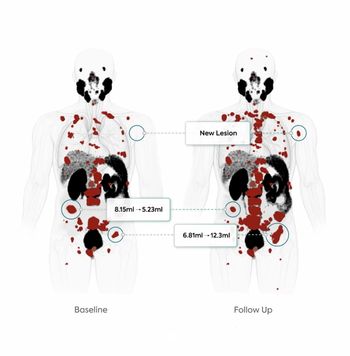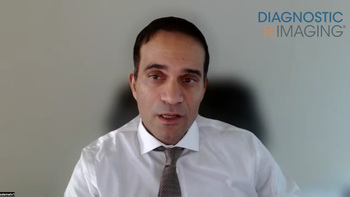
RIS-PACS connections take priority in healthcare networks
Stand-alone software has become an anachronism in a modern-day hospital. Radiology departments across Europe are seeking seamless RIS-PACS integration as a minimum requirement for new digital data management software. The move to RIS-PACS packages is expected to aid imaging workflow while providing a stepping-stone to complete information integration within hospitals, health authorities, and wider regions.
Stand-alone software has become an anachronism in a modern-day hospital. Radiology departments across Europe are seeking seamless RIS-PACS integration as a minimum requirement for new digital data management software. The move to RIS-PACS packages is expected to aid imaging workflow while providing a stepping-stone to complete information integration within hospitals, health authorities, and wider regions.
The need for better integration between information systems became clear when hospitals in Galicia, Spain, had the opportunity to choose a new RIS. Representatives from hospitals throughout the northwest region of Spain determined that their new system should support data generated at every step, from initial request to final report, and should also offer radiologists access to imaging results directly from the RIS user interface.
"Of course, we needed integration with the image world. This was not the case with the previous RIS," said Javier Quiles, a researcher in the department of informatics at Complejo Hospitalario Universitario de Santiago in Spain.
Galicia's 14 public hospitals and hospital trusts made the decision to switch to a different RIS primarily as a result of new European Union legislation. An EU directive that entered Spanish law in 1999 and 2001 mandates use of procedures to keep medical x-ray burden to a minimum and requires that information on dose be recorded. Another law, dictating stringent levels of data protection on IT systems, was also passed in 2001. Both laws prompted officials to address the issue of quality assurance in radiology departments and to ensure that their information systems meet all statutory obligations.
A working group comprising nine radiologists, three IT experts, and a medical physicist assessed the ability of the existing RIS in Galicia's hospitals to meet the needs of its 1000 end users, said Quiles, a member of the working group. The group concluded that the RIS, which had been in operation regionwide since 1997, had several failings. Most crucially, it lacked integration with imaging systems and could not support data related to QA fulfillment. Radiology personnel were unable to register and validate imaging requests or monitor stocks of pharmacy products and general supplies. The RIS also failed to meet Spanish law on protecting health data.
Group members devised a seven-point checklist for an improved imaging information system known as SIDI (Sistema de Informacion de Diagnostico por la Imagen):
- support all steps of scheduled radiological workflow;
- register patient radiation dose;
- provide image access from the RIS user interface;
- provide access to electronic patient record from the RIS user interface;
- offer full integration with existing information systems;
- support all QA information, including equipment upgrades; and
- support research and teaching through a dedicated file of case studies.
The group opted to implement SIDI through a proprietary application, rather than purchasing off-the-shelf software. No vendor solution they examined could support all the desired functionalities.
"We decided that we wanted some customized features that were not available in most commercial solutions, and we wanted to use our existing infrastructure," Quiles said. "So the decision was taken to go with an in-house development."
The first implementation of SIDI is under way at a hospital trust in the areas surrounding Vigo, one of Galicia's main cities. The Complejo Hospitalario Universitario de Vigo (CHUVI) includes three hospitals and serves a population of about 450,000. The network backbone has been upgraded to 1 Gbps, and clinical departments will be linked via 100-Mbps connections. Installation of a DICOM server, diagnostic workstations, and an archive facility will precede a gradual rollout through radiology departments, intensive care units, and emergency care services. A Web-based enterprise-wide image distribution system will provide image access to clinical areas, and the hospital's mammography services will be digitized.
"We hope that in 2006 we will have a totally filmless hospital," Quiles said.
ALTERNATE SOLUTION
Radiologists in the Modena province of Italy will soon be using an integrated RIS-PACS as well, although they have selected a commercially available solution. Modena has two separate public healthcare organizations, Azienda USL and Azienda Ospedaliera, which control nine public hospitals and 2400 beds between them. The two organizations purchased a common RIS in 1980 but developed digital imaging management software independently, said Giancarlo Conti, clinical engineer with Azienda USL. They decided in 2003 to install a common integrated RIS-PACS architecture, creating a virtual radiology service across the entire region.
A working group composed of radiologists, radiographers, clinicians, executives, and engineers drew up a wish list of features for the integrated RIS-PACS, including:
- adequate online (lossless) and offline (lossy and lossless) storage;
- rapid image retrieval (four seconds in main hospitals, 10 seconds elsewhere);
- scalability options (assuming increased users and images produced);
- maximized uptime and efficient disaster recovery;
- integration with other systems according to IHE profiles; and
- easy import of data from modalities and different PACS and/or storage devices.
Vendors that submitted a bid were ranked according to a points system. A total of 60 points were available for the proposed system's technical quality, including its RIS-PACS architecture, adherence to standards, reliability, and likely levels of support and customer assistance. The remaining 40 points were allocated according to economic criteria.
A partner was chosen in early 2004, and implementation began two months later, Conti said. Phase I of the wide area project went live just two days before September's EuroPACS/MIR meeting.
MULTISITE BENEFITS
The advantages of RIS-PACS integration in a multisite environment are already being realized at Newcastle Upon Tyne Hospitals NHS Trust in northeast England, according to Robert Shaw, head of IT at the hospital. Newcastle is one of the largest teaching and tertiary referral hospitals in the U.K., with a staff of about 11,000 people. It spans three main hospitals-Royal Victoria Infirmary, Newcastle General Hospital, and Freeman Hospital-as well as a number of smaller sites. The radiology, radiotherapy, and nuclear medicine services together acquire more than eight million images per year.
The Newcastle RIS-PACS relies on robust architecture and infrastructure to make it work, Shaw said. Fiber-optic cables provide a high-bandwidth local area network between and within separate sites, and a firewall protects the network from externally introduced viruses. Backbone areas are guaranteed 99.8% uptime.
"This is really important, because it gives clinicians the confidence to throw away film and use the technology on their desk with patients," Shaw said. "We have recently started to implement a wireless network as well in the Freeman Hospital, which means consultants can walk around wards with wireless tablets during their rounds, rather than using a trolley full of patient notes."
A Web-based system offers instant access to images. Users can log on to one of 5000 desktop computers and call up results from current or past examinations, Shaw said. This use of Web technology frees the IT department of the burden of maintaining software on the numerous client PCs. Implementation of 24-TB storage area networks working as mirrored pairs also enables the Trust to store every image online. Should one SAN fail, as it did during a power interruption in May, the system simply switches over to the other.
"There is no deep archive or tape at all," Shaw said. "We felt we had to have online storage to deliver images to multidisciplinary teams. The PACS and RIS are integrated too, and again this helps us deliver information at the point of care. That is what clinicians want us to do."
The range and age of the Trusts' modalities were a major challenge to achieving an integrated imaging workflow, he said. Legacy equipment claiming DICOM compliance did not always function as expected.
"We have one manufacturer with one particular version of software on an MR scanner that we still have difficulty with," Shaw said.
The size of the project also posed a logistical problem for training. IT managers developed an online learning package three months before going digital, and they encouraged all 4000 potential RIS-PACS users to work through simulated scenarios. Online forms replaced paper-based administration.
Although the RIS-PACS is working well, complete enterprise-wide integration will mean linking imaging data-and not just radiological imaging data-with other types of patient information.
"In terms of clinicians out on the wards and in theatre, imaging data are only one part of the information they need. So it is important we integrate these within the rest of the electronic patient record," Shaw said.
To ensure data integrity in such a system, each image should be tagged with a unique patient identifying number. The larger the number of institutions using this same number, the easier it will be to integrate record systems locally, across wider regions, and even nationwide. All U.K. citizens are already allocated a unique NHS number, although it is rarely used at present.
DIGITAL DATA EXCHANGE
Prof. Alessandro Pepino looks forward to an eventual seamless integration between the PACS and RIS and the administrative and clinical information systems at the Monaldi Hospital in Naples, Italy. For now, however, his vision of trouble-free, digital data exchange at the 600-bed public hospital is limited by budget restrictions.
"We do not have the resources for a global integration project," said Pepino, a professor of bioengineering at the University of Naples Federico II.
The Monaldi Hospital, which specializes in heart and lung disease, acquired a Web-based PACS and RIS in 2002. Software for both systems is integrated and loaded onto all five of the hospital's diagnostic workstations so images can be recalled during reporting. Clinicians can access medical images from the many PCs located throughout outpatient areas, administrative offices, and wards.
Integration between the RIS-PACS and other clinical and administrative data is problematic because the latter systems are generally not HL7-compliant, Pepino said. A solution has been introduced, however, to provide partial integration between patient admission and radiology workflow. All patients arriving at the Monaldi Hospital receive an admission number, which is printed on their hard-copy medical record and on a number of barcoded labels. One label is placed on a bracelet for patients to wear throughout their stay, and the others are used to identify any paper documents relating to them. The admission number also serves as a unique identifier for a patient's radiology requests, images, and reports.
"We consider this admission number as the unit key inside the hospital. The advantage is that when the patient arrives with the barcoded label, it is quite easy to access in one step any information concerning that patient, using the barcode reader," Pepino said.
But hospital-wide information integration isn't just about software systems. Efficient workflow demands good integration between technology and end users as well. Pepino advocates a two-tier strategy for troubleshooting. Queries should initially be directed to staff at a dedicated help desk, who will decide whether vendor support is needed. The majority of users' problems can be solved internally, and only around 5% need outside assistance.
"You need people to act as a sort of 'glue' between the technology providers and end users," he said. "These people should be based in the hospital, so they know the environment and know the problem. But a mistake I see in many hospitals is that this role is covered by a superuser. That is absolutely wrong, because this is an unusual role to give to a physician."
Newsletter
Stay at the forefront of radiology with the Diagnostic Imaging newsletter, delivering the latest news, clinical insights, and imaging advancements for today’s radiologists.



























